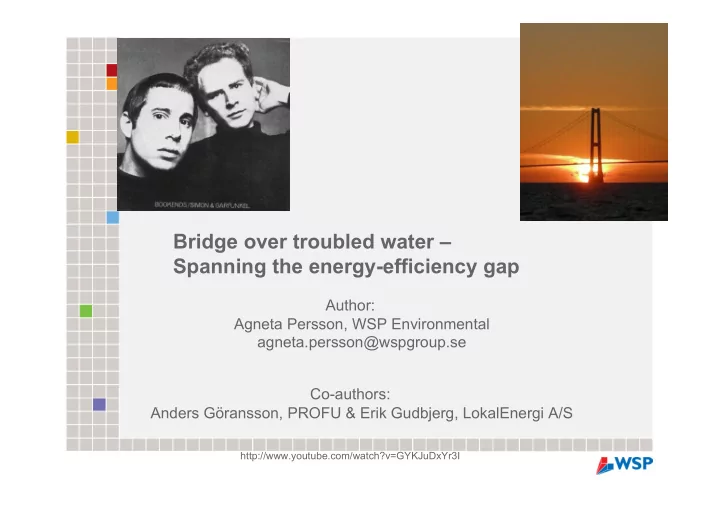

Bridge over troubled water – Spanning the energy-efficiency gap Author: Agneta Persson, WSP Environmental agneta.persson@wspgroup.se Co-authors: Anders Göransson, PROFU & Erik Gudbjerg, LokalEnergi A/S http://www.youtube.com/watch?v=GYKJuDxYr3I
Bridge over troubled water – Spanning the energy-efficiency gap (Persson A et al.) The Swedish Inquiry on the EU Energy Services Directive (2006/32/EU) carefully studied the following questions: What size is the cost-efficient energy-efficiency potential? What characteristics does it have? Which measures are cost efficient? What part of the cost-efficient measures is likely to be realised?
Bridge over troubled water – Spanning the energy-efficiency gap (Persson A et al.) Commonly engineers and economists give different answers to these questions To bring us closer to a common opinion the inquiry put together a working group including both engineers and economists
Bridge over troubled water – Spanning the energy-efficiency gap (Persson A et al.) The working group seeked to quantify - the cost-efficient potential - the energy-efficiency gap and - different factors affecting the gap Concrete calculations were carried out, both socio-economical and business/private economical
Bridge over troubled water – Spanning the energy-efficiency gap (Persson A et al.) The working group focused on the building sector Calculations were based on - CBA - national energy statistics - net present values - standard intervals for planned maintenance and refurbishment - costs included investments, material, labour, transaction costs (time to find, time to decide, loss of comfort…) - benefits included reduced operational and maintenance costs; decreased environmental costs etc
Bridge over troubled water – Spanning the energy-efficiency gap (Persson A et al.) Almost all e-eff measures are connected with some kínd of costs seldom are put in monetary terms The study put major effort into quantifying such costs These costs are often equal in socio-economical and decision maker calculations
Bridge over troubled water – Spanning the energy-efficiency gap (Persson A et al.) 4 % real discount interest rate + Sensitivity analysis Energy costs: variable part of energy cost Energy cost forecasts + sensitivity analysis External effects included, sensitivity analysis on how to value these costs
Bridge over troubled water – Spanning the energy-efficiency gap (Persson A et al.) Total building (residential + non-residential) energy end use 135 TWh/year Cost-efficient potential by 2016: 25 % or 34 TWh/year + conversion from el. to district heating, heat pumps etc A major part of the cost-efficient potential consists of no or low- cost measures
Bridge over troubled water – Spanning the energy-efficiency gap (Persson A et al.) What part is estimated to be realised by 2016? Merely 15 % of retrofit possibilities => 5 TWh/year 3 TWh/year due to individual household decisions (e.g. new appliances) Makes a total of 8 TWh Conclusion: The energy-efficiency gap is substantial!
Bridge over troubled water – Spanning the energy-efficiency gap (Persson A et al.) Quantified cost-efficient potential
Bridge over troubled water – Spanning the energy-efficiency gap (Persson A et al.) The energy-efficiency gap
Bridge over troubled water – Spanning the energy-efficiency gap (Persson A et al.) Two of the calculated energy-efficiency potential cases, division between building categories
Bridge over troubled water – Spanning the energy-efficiency gap (Persson A et al.) Conclusions: There’s a huge cost-efficient potential Some e-eff gap factors were possible to quantify Financial aspects do not alone explain market behaviour Cost-efficient measures often need support “to make it happen” It is socio-economical beneficial to support cost-efficient measures Transaction costs & split incentive problems can be often be cost-efficiently lowered by e.g. information measures Further policy measures are needed to span a larger part of the e-eff gap!
Bridge over troubled water – We managed to span parts of the gap Thanks for your attention! Questions? agneta.persson@wspgroup.se, +46-70 546 76 53
Recommend
More recommend